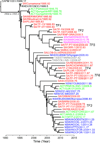Molecular epidemiology of Rabbit Haemorrhagic Disease Virus in Australia: when one became many
- PMID: 24251353
- PMCID: PMC4595043
- DOI: 10.1111/mec.12596
Molecular epidemiology of Rabbit Haemorrhagic Disease Virus in Australia: when one became many
Abstract
Rabbit Haemorrhagic Disease Virus (RHDV) was introduced into Australia in 1995 as a biological control agent against the wild European rabbit (Oryctolagus cuniculus). We evaluated its evolution over a 16-year period (1995-2011) by examining 50 isolates collected throughout Australia, as well as the original inoculum strains. Phylogenetic analysis of capsid protein VP60 sequences of the Australian isolates, compared with those sampled globally, revealed that they form a monophyletic group with the inoculum strains (CAPM V-351 and RHDV351INOC). Strikingly, despite more than 3000 rereleases of RHDV351INOC since 1995, only a single viral lineage has sustained its transmission in the long-term, indicative of a major competitive advantage. In addition, we find evidence for widespread viral gene flow, in which multiple lineages entered individual geographic locations, resulting in a marked turnover of viral lineages with time, as well as a continual increase in viral genetic diversity. The rate of RHDV evolution recorded in Australia -4.0 (3.3-4.7) × 10(-3) nucleotide substitutions per site per year - was higher than previously observed in RHDV, and evidence for adaptive evolution was obtained at two VP60 residues. Finally, more intensive study of a single rabbit population (Turretfield) in South Australia provided no evidence for viral persistence between outbreaks, with genetic diversity instead generated by continual strain importation.
Keywords: European rabbit; Rabbit Haemorrhagic Disease Virus; biocontrol; epidemiology; evolution; phylogeny.
© 2013 John Wiley & Sons Ltd.
Figures




Similar articles
-
Detection of rabbit haemorrhagic disease virus (RHDV) in nonspecific vertebrate hosts sympatric to the European wild rabbit (Oryctolagus cuniculus).Infect Genet Evol. 2011 Aug;11(6):1469-74. doi: 10.1016/j.meegid.2011.05.001. Epub 2011 May 11. Infect Genet Evol. 2011. PMID: 21600308
-
Rabbit Hemorrhagic Disease Virus 2 (RHDV2; GI.2) Is Replacing Endemic Strains of RHDV in the Australian Landscape within 18 Months of Its Arrival.J Virol. 2018 Jan 2;92(2):e01374-17. doi: 10.1128/JVI.01374-17. Print 2018 Jan 15. J Virol. 2018. PMID: 29093089 Free PMC article.
-
Genetic variation and phylogenetic analysis of rabbit haemorrhagic disease virus (RHDV) strains.Acta Biochim Pol. 2012;59(4):459-65. Epub 2012 Dec 13. Acta Biochim Pol. 2012. PMID: 23240105 Review.
-
Comparative Phylodynamics of Rabbit Hemorrhagic Disease Virus in Australia and New Zealand.J Virol. 2015 Sep;89(18):9548-58. doi: 10.1128/JVI.01100-15. Epub 2015 Jul 8. J Virol. 2015. PMID: 26157125 Free PMC article.
-
Rabbit haemorrhagic disease (RHD) and rabbit haemorrhagic disease virus (RHDV): a review.Vet Res. 2012 Feb 10;43(1):12. doi: 10.1186/1297-9716-43-12. Vet Res. 2012. PMID: 22325049 Free PMC article. Review.
Cited by
-
Structural Basis for Rabbit Hemorrhagic Disease Virus Antibody Specificity.J Virol. 2022 Nov 23;96(22):e0121722. doi: 10.1128/jvi.01217-22. Epub 2022 Nov 3. J Virol. 2022. PMID: 36326275 Free PMC article.
-
Benign Rabbit Caliciviruses Exhibit Evolutionary Dynamics Similar to Those of Their Virulent Relatives.J Virol. 2016 Sep 29;90(20):9317-29. doi: 10.1128/JVI.01212-16. Print 2016 Oct 15. J Virol. 2016. PMID: 27512059 Free PMC article.
-
Surveillance of Wildlife Viruses: Insights from South Australia's Monitoring of Rabbit Haemorrhagic Disease Virus (RHDV GI.1 and GI.2).Viruses. 2024 Sep 30;16(10):1553. doi: 10.3390/v16101553. Viruses. 2024. PMID: 39459889 Free PMC article.
-
Rabbit haemorrhagic disease: virus persistence and adaptation in Australia.Evol Appl. 2014 Nov;7(9):1056-67. doi: 10.1111/eva.12195. Epub 2014 Aug 14. Evol Appl. 2014. PMID: 25553067 Free PMC article.
-
Increased virulence of rabbit haemorrhagic disease virus associated with genetic resistance in wild Australian rabbits (Oryctolagus cuniculus).Virology. 2014 Sep;464-465:415-423. doi: 10.1016/j.virol.2014.06.037. Epub 2014 Aug 21. Virology. 2014. PMID: 25146599 Free PMC article.
References
-
- Abrantes J, Esteves PJ, van der Loo W. Evidence for recombination in the major capsid gene VP60 of the rabbit haemorrhagic disease virus (RHDV) Archives of Virology. 2008;153:329–335. - PubMed
-
- Asgari S, Hardy JR, Sinclair RG, Cooke BD. Field evidence for mechanical transmission of rabbit haemorrhagic disease virus (RHDV) by flies (Diptera: Calliphoridae) among wild rabbits in Australia. Virus Research. 1998;54:123–132. - PubMed
Publication types
MeSH terms
Substances
Associated data
- Actions
- Actions
- Actions
- Actions
- Actions
- Actions
- Actions
- Actions
- Actions
- Actions
- Actions
- Actions
- Actions
- Actions
- Actions
- Actions
- Actions
- Actions
- Actions
- Actions
- Actions
- Actions
- Actions
- Actions
- Actions
- Actions
- Actions
- Actions
- Actions
- Actions
- Actions
- Actions
- Actions
- Actions
- Actions
- Actions
- Actions
- Actions
- Actions
- Actions
- Actions
- Actions
- Actions
- Actions
- Actions
- Actions
- Actions
Grants and funding
LinkOut - more resources
Full Text Sources
Other Literature Sources

